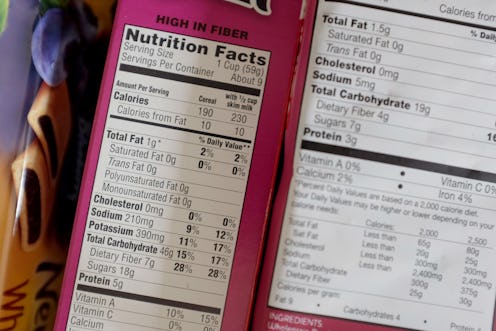Life
6 Scary-Sounding Ingredients That Are OK To Eat
There's a lot of emphasis on eating whole foods these days, and for good reason. With so much processed foods on the shelves, it can be hard to differentiate between harmful chemicals and preservatives, and igredients that sound scary but are actually harmless. Although it's always a safe bet to opt for choices with less ingredients or cook your food from scratch, sometimes you need to pick up foods on-the-go. In this case, it's good to know what to look out for, and what isn't worth worrying about.
Though oftentimes ready-made foods can include some seriously sketchy ingredients, there are instances where food contains additives that won't hurt your health. They are usually used to stabilize and maintain food, so it doesn't lose its texture and has a longer shelf life. As long as you consume these ingredients in small quantities, you won't have to worry about their effect on your health.
"My recommendation is that consumers avoid products that have multiple ingredients that they cannot pronounce (with the exception of those below)," says Westin Childs, MD, over email. "One or two may be ok, but for the most part 90 percent or more of those ingredients may actually be harmful in the long run."
Next time you're staring at a food label worrying if that strange-sounding ingredient is going to end up killing you, try to rest easy if you see the following six ingredients, which sound frightening, but are actually okay to consume.
1. Guar Gum
Guar gum is a thickening and emulsifying agent derived from guar beans. It is often used in ice cream to help prevent ice crystals from forming. Because it is used in small amounts within foods, it is safe to consume. However, avoid taking any guar gum supplements, which can be harmful in higher doses.
2. Lactobacillus acidophilus
A probiotic that is often added to dairy products, lacobacillus acidophilus may sound intimidating, but it is actually good for your digestion. "Lactobacillus acidophilus is a common bacteria that promotes a healthy gut flora," says Amber Reynolds, MS, RDN over email.
3. Xanthan Gum
"Xanthan gum is a bacteria that's a harmless thickener," says Abby Langer, RD to Bustle over email. The thickener is used to help ingredients blend more effectively, and it used in very small amounts. No studies have found any negative health effects, so it is perfectly safe to consume.
4. Oligosaccharide
Found naturally in foods such as artichokes, asparagus, and broccoli, it is sometimes added in foods to add additional fiber. "Oligosaccharide is an indigestible carbohydrate that is added for fiber as a prebiotic," says Reynolds. It is a natural constituent of different plants, and can help keep things flowing smoothly in the digestive tract.
5. Amylase
"Amylase is a natural enzyme — we actually produce amylase in our mouths and pancreas — added to baked goods as food for the yeast," says Reynolds. It helps to break down starch and keep the doughy consistency of baked goods, and it has no harmful health effects.
6. Gluconic Acid
Gluconic acid is a safe, organic acid that is derived from glucose (sugar). It occurs naturally in fruit, honey, and wine, but it is added to beverages, baked goods, and dairy products to regulate acidity.
If strange-sounding ingredients freak you out, use this list as a guide and you'll officially having nothing to worry about except choosing what you want for dessert.
Images: sweet_flour, epw, jeepersmedia, theimpulsivebuy/Flickr;
